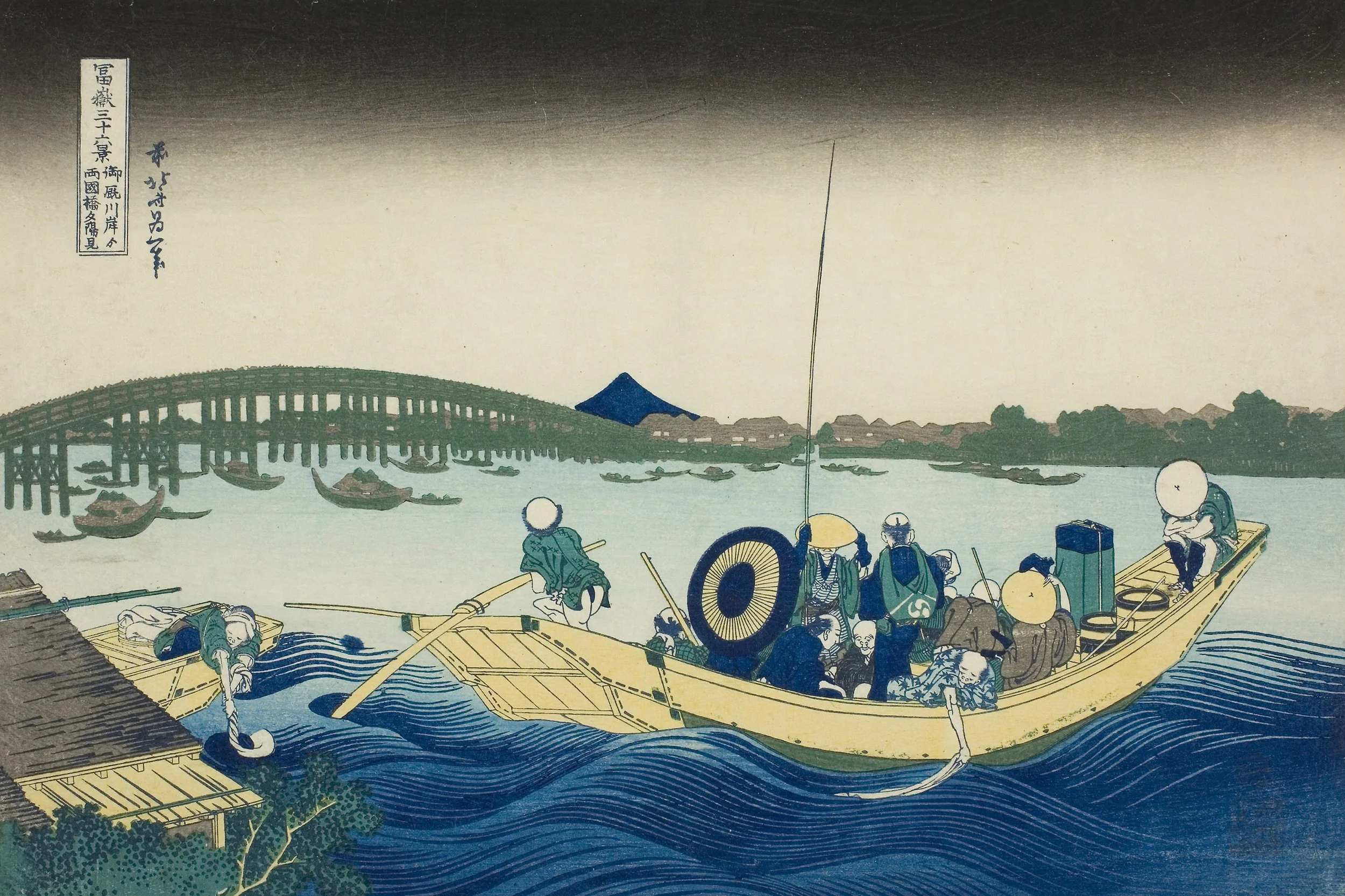25.Koishikawa yuki no ashita 礫川雪の且
Koishikawa Yuki no Ashita (Snowy Morning at Koishikawa)
The area corresponds to present-day Koishikawa in Bunkyō Ward, Tokyo.
In the past, teahouses lined this elevated area with a view of Mt. Fuji.
The scene depicts snow-viewing with sake from one of those teahouses.
During the Edo period, Japan was in a “Little Ice Age,”
and snowfall occurred slightly more frequently than today.
To fully depict the snowy atmosphere, Hokusai uses a pulled-back composition.
If he had shown the view of Mt. Fuji from inside a teahouse, as in Tōkaidō Yoshida,
he wouldn’t have been able to render the snow sufficiently—
the focus would shift too much to the interior.
Thus,
he divides the picture horizontally into two parts:
Snow below, sky above.
On the horizon line, the snow-viewing figure and Mt. Fuji engage in visual dialogue.
While capturing the snow fully,
the snow-viewer and Fuji are linked with a powerful visual line.
Snow, the snow-viewing guest, and Mt. Fuji—
these three subjects are depicted with nothing left out.
Koishikawa Yuki no Ashita (Snowy Morning at Koishikawa)
The area corresponds to present-day Koishikawa in Bunkyō Ward, Tokyo.
In the past, teahouses lined this elevated area with a view of Mt. Fuji.
The scene depicts snow-viewing with sake from one of those teahouses.
During the Edo period, Japan was in a “Little Ice Age,”
and snowfall occurred slightly more frequently than today.
Image: Koishikawa Yuki no Ashita
To fully depict the snowy atmosphere, Hokusai uses a pulled-back composition.
If he had shown the view of Mt. Fuji from inside a teahouse, as in Tōkaidō Yoshida,
he wouldn’t have been able to render the snow sufficiently—
the focus would shift too much to the interior.
Thus,
he divides the picture horizontally into two parts:
Snow below, sky above.
On the horizon line, the snow-viewing figure and Mt. Fuji engage in visual dialogue.
While capturing the snow fully,
the snow-viewer and Fuji are linked with a powerful visual line.
Snow, the snow-viewing guest, and Mt. Fuji—
these three subjects are depicted with nothing left out.
There are many masterpieces on the theme of snow and the people viewing it.
But often, the viewer is absorbed into the landscape,
blending in as part of the scene.
In Koishikawa Yuki no Ashita,
the composition places the Fuji viewer within the snow.
The one who sees—the snow-viewer—and the one being seen—Mt. Fuji—
stand face to face on equal terms.
Because of this, the viewer stands out within the landscape.
The subject is expressed to its fullest.
Hokusai’s aesthetic sensibility resides here.
There are many masterpieces on the theme of snow and the people viewing it.
But often, the viewer is absorbed into the landscape,
blending in as part of the scene.
In Koishikawa Yuki no Ashita,
the composition places the Fuji viewer within the snow.
The one who sees—the snow-viewer—and the one being seen—Mt. Fuji—
stand face to face on equal terms.
Because of this, the viewer stands out within the landscape.
The subject is expressed to its fullest.
Hokusai’s aesthetic sensibility resides here.
13
26.Sunset Over the Ryogoku Bridge 御厩川岸より両国橋夕陽見
TBA

